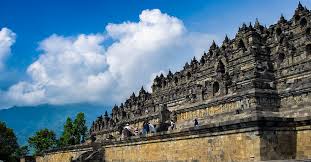Borobudur Temple, located in Central Java, Indonesia, is not only one of the most significant Buddhist monuments in the world but also a symbol of Indonesia’s rich cultural heritage. This architectural marvel, built during the 8th and 9th centuries, offers a profound insight into the country’s ancient civilization and religious practices. In this article, we will delve into the cultural significance of Borobudur Temple, exploring its history, architectural grandeur, religious importance, and its role in modern Indonesia.
Historical Background

Borobudur Temple was constructed during the Syailendra Dynasty, a prominent Buddhist kingdom that ruled over Java between the 8th and 9th centuries. The temple was built under the reign of King Samaratungga, and its construction likely took place between 780 and 840 AD. This period was marked by the flourishing of Buddhism in the region, which had a profound influence on the culture, art, and architecture of Java.
The temple’s construction is believed to have been a grand project involving thousands of artisans and laborers. However, over time, Borobudur fell into neglect and was gradually buried under volcanic ash and jungle growth. It was rediscovered in the early 19th century by the British during the colonial period, leading to extensive restoration efforts and its designation as a UNESCO World Heritage Site in 1991.
Architectural Grandeur
Borobudur Temple is renowned for its intricate and colossal architecture. It is built in the form of a massive mandala, symbolizing the universe in Buddhist cosmology. The temple is constructed from andesite stone and consists of nine stacked platforms, including six square platforms and three circular ones, topped with a central dome. The structure is adorned with over 2,600 relief panels and 504 Buddha statues, each meticulously carved and positioned to convey various aspects of Buddhist teachings and stories.
Design and Structure
- Nine Levels: The temple’s nine levels represent a journey from the earthly realm to the enlightened state of Nirvana. Visitors traditionally ascend the temple in a clockwise direction, moving from the lower square platforms, which depict the world of desire, to the upper circular platforms, representing the realm of pure enlightenment.
- Relief Panels: The relief panels, covering over 1.5 kilometers, illustrate scenes from the Jataka tales, the life of Buddha, and various Buddhist cosmology. These panels offer a visual narrative of Buddhist philosophy and the moral teachings of the religion.
- Stupas and Buddha Statues: The uppermost circular platforms are adorned with 72 stupas, each containing a statue of Buddha. The stupas are designed to symbolize the universe’s perfection and the path to spiritual enlightenment.
Religious and Cultural Significance
Borobudur Temple holds immense religious significance as a center of Buddhist worship and meditation. It represents the embodiment of Mahayana Buddhism, which emphasizes the path to enlightenment through the guidance of the Bodhisattvas. The temple’s design and its reliefs are intended to guide practitioners on their spiritual journey, reflecting the integration of Buddhist beliefs with local cultural traditions.
Buddhist Pilgrimage
As one of the greatest Buddhist monuments, Borobudur attracts pilgrims from around the world who visit to pay homage, meditate, and participate in religious ceremonies. The temple is a focal point for the annual Vesak celebration, marking the birth, enlightenment, and death of Buddha. During this festival, thousands of Buddhists gather to perform rituals and participate in processions around the temple.
Cultural Heritage
Borobudur is not just a religious site but also a cultural symbol of Indonesia’s heritage. It represents the architectural and artistic achievements of ancient Javanese civilization and the integration of Buddhist practices with local traditions. The temple’s cultural importance extends beyond its religious context, reflecting Indonesia’s historical evolution and its role in global heritage.
Preservation and Restoration Efforts
The preservation of Borobudur Temple has been a significant concern for both Indonesian authorities and international organizations. The temple has faced challenges from natural elements, such as volcanic eruptions and erosion, as well as human activities. Restoration efforts have been ongoing since the 19th century, with notable projects including the cleaning and repairing of relief panels, stabilization of the structure, and protection against environmental damage.
UNESCO World Heritage Status
In 1991, Borobudur Temple was designated as a UNESCO World Heritage Site, recognizing its outstanding universal value. The designation has led to increased international support and funding for its preservation and has helped raise global awareness of its cultural significance.
Community Involvement
Local communities play a crucial role in the preservation of Borobudur. Initiatives involve training local guides, promoting sustainable tourism practices, and involving local artisans in restoration projects. This community engagement helps ensure the temple’s preservation while providing economic benefits to the surrounding region.
Borobudur in Modern Indonesia

In contemporary Indonesia, Borobudur Temple remains a symbol of national pride and cultural identity. It serves as a key tourist attraction, drawing visitors from around the world to experience its historical and spiritual significance. The temple also plays a role in promoting cultural tourism and fostering understanding between different religious and cultural groups.
Tourism and Education
The temple’s popularity as a tourist destination has led to the development of surrounding infrastructure, including museums, visitor centers, and guided tours. These facilities provide educational resources about Borobudur’s history, architecture, and religious significance, enhancing the visitor experience and promoting cultural awareness.
Cultural Events and Festivals
Borobudur continues to host cultural events and festivals, such as the annual Borobudur Festival, which celebrates traditional Javanese culture through music, dance, and art. These events contribute to the temple’s role as a living cultural site and help preserve Indonesia’s rich artistic heritage.
Conclusion
Borobudur Temple stands as a testament to the artistic, architectural, and spiritual achievements of ancient Javanese civilization. Its significance extends beyond its religious context, representing Indonesia’s rich cultural heritage and its place in global history. As a UNESCO World Heritage Site, Borobudur continues to captivate visitors and scholars alike with its intricate design, historical depth, and enduring legacy. Understanding the cultural significance of Borobudur provides valuable insights into Indonesia’s past and its ongoing commitment to preserving its historical treasures for future generations.



